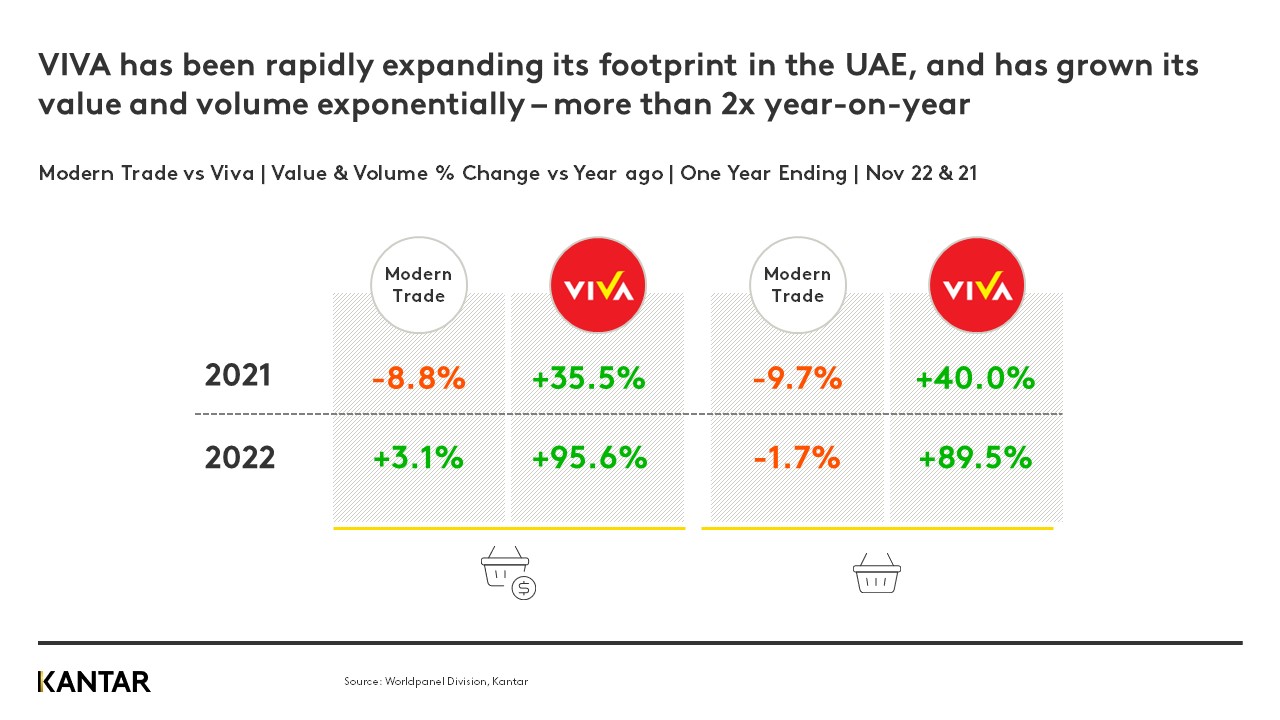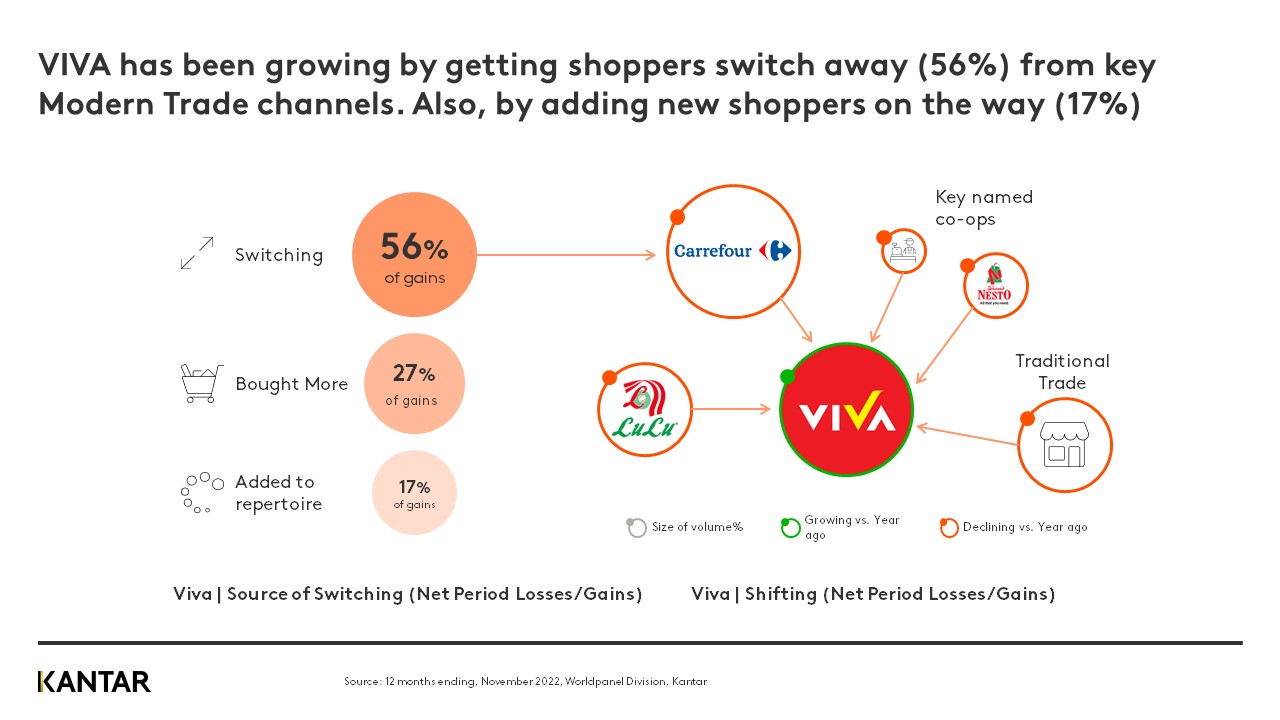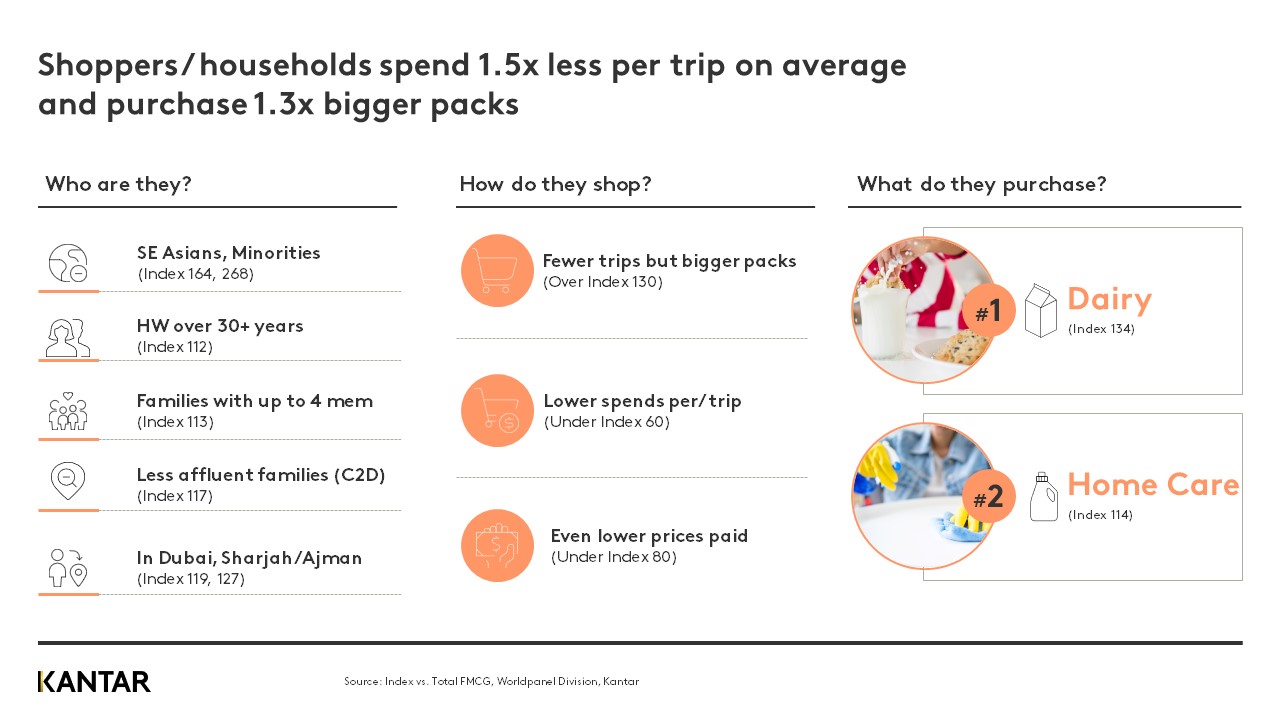A well-established concept in the West, discounters have caused a paradigm shift in the retail landscape. Popular supermarkets have lost market share to the channel over the last 10 years: in the UK, for example, discounters like Aldi and Lidl have quadrupled their share of volume purchased – eating into the share once held by Tesco, Asda and Morrisons.
In the face of the ongoing global cost-of-living crisis, discounters are expected to further increase their share of the grocery market, prompted by cash strapped households looking for bargain buys.
While in the UAE the discounter format is relatively new, it has been readily embraced much like in other global regions. Notably, one of the early adopters, VIVA – which opened its doors in 2018 – now has a substantial reach, catering to around one third of the households in UAE, with a penetration of 27%, almost doubling in two years.
Although VIVA’s growth has been fuelled by the recent pandemic – spend grew by 35.5% and volume by 40% in 2021, when households were looking for greater value for every dirham they spent – the momentum has not slowed. Spend increased by 95.6% and volume by 89.5% in 2022. This suggests that households will always tend to resort to value seeking measures in times of crisis.

Will the discounter phenomenon in UAE be as big as Aldi/Lidl in Europe?
Let’s understand what fuels a discounter’s growth. The attraction is simple: it offers high-quality products at a cheaper price. For example, out of 73 categories tracked by Worldpanel’s UAE panel, VIVA shoppers pay less for 65 of them – essentially resulting in a saving of around 25% compared with popular supermarkets.
This indicates that discounters in the market pose a potential threat to the mighty super and hypermarkets. Worldpanel data suggests likewise. In the past year, 56% of VIVA’s volume growth has been driven by households switching from key modern trade channels. This trend mirrors the growth trajectory of Aldi and Lidl!
 Busting the myth: value appeals to all levels of affluence
Busting the myth: value appeals to all levels of affluence
The notion of value shopping only appealing to lower-income households has been debunked by the rise of discounters in the UAE.
Currently, shoppers who visit discounters spend on average 1.5 times less per shopping trip. Mainly less affluent households predominantly purchase categories that are either to be consumed fresh, such as dairy, or have a longer shelf life, such as pantry and household essentials.

However, while shopping in discounters might have carried a stigma over a decade ago, today even affluent households are happy to abandon a family favourite for an almost identical product from a less well-known brand if it means saving money. A significant proportion of the heaviest shoppers at VIVA, for example, come from the highest socio-economic groups.
Large FMCG brands are being squeezed…
The exponential growth of discounters is also eroding the market share of mainstream brands. A large percentage of the brands' discounters stock are exclusive to them, sourced in bulk, direct from the manufacturer. This allows them to pass the savings on to consumers.
For example, only 20% of the 1,200 products stocked by VIVA are established European or Asian brands, and purchases of these are declining. The remaining 80% of stocked brands – such as Balaji, MC Snacker and Wanted – are seeing more than 100% growth in volume year-on-year.
With global food prices continuing to soar, discounters in the UAE will pose a significant threat to major supermarkets and FMCG manufacturers alike if they continue to grow at the current rate. While Aldi and Lidl do stock brands with global appeal, FMCG manufacturers need to explore potential partnerships to ride the hard discounter wave.
…but a discounter listing can be a win-win!
A mutually beneficial win-win position can be reached by FMCG manufacturers to get their brand listed by discounters. Worldpanel data on global markets shows us that there is little cannibalisation of sales of other brands when this happens – instead, it leads to growth in both buyer base and sales volume. This is because consumers appreciate having a choice within the category, and the opportunity to buy that brand during their trip to the discounter.
While there isn’t a handbook on turning a discounter listing into a win-win, FMCG manufacturers can begin by understanding:
- Is their category or SKU growing or strong already?
- Is their category highly visible in store?
- Do they offer a discounter price point with a pack size that justifies the expected premium?
Worldpanel can help FMCG manufacturers operating in the UAE to initiate dialogue with discounters, leveraging Worldpanel data to understand how they are growing. Manufacturers can also take advantage of Worldpanel’s category manager and assortment tool to find out how both they and the discounter can grow through stocking the optimum product range.
Reach out to our experts for more information.


